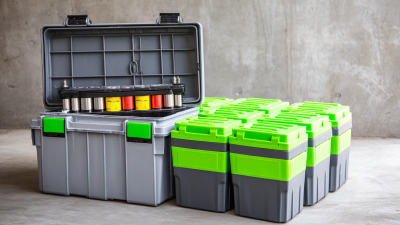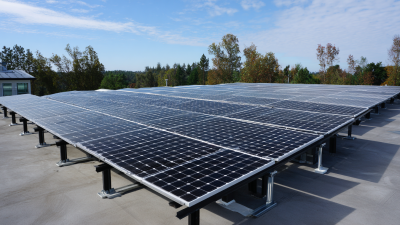ALL PRODUCTS
- Solar Panel
- Hybrid Inverter
- Lithium Battery
GSB SOLAR LITHIUM BATTERIES
- Gel Battery
- Solar Street Lights
- Pump Inverter
In today's rapidly evolving energy landscape, the pursuit of energy independence has never been more critical. A well-designed solar power system can significantly enhance a household's ability to generate and store solar energy, but the choice of a suitable battery for solar systems remains a pivotal decision. According to Mark Z. Green, a leading expert in renewable energy systems, "The right battery for your solar system not only maximizes energy storage but also optimizes the efficiency of your entire solar setup." This highlights the importance of understanding the various battery technologies available and selecting one that aligns with individual energy needs.

As homeowners increasingly look to harness solar energy, the focus often shifts to which battery will best complement their solar panels. With advancements in battery technology, options such as lithium-ion, lead-acid, and saltwater batteries offer diverse benefits ranging from lifespan to cost-effectiveness. It's essential to evaluate the characteristics of these batteries to determine which type provides the optimal performance for your solar system. By exploring the top five batteries on the market, we can guide you through making an informed choice that bolsters your energy independence and sustainability efforts.
Energy independence is increasingly recognized as a crucial goal for both individuals and societies, particularly in the context of renewable energy systems like solar power. According to a report by the International Energy Agency (IEA), countries that prioritize energy independence can reduce their vulnerability to fluctuating energy prices and geopolitical tensions. By harnessing solar energy, homeowners can diminish reliance on fossil fuels and traditional power grids, enabling them to gain control over their energy supply.
The importance of selecting the right battery for a solar system cannot be overstated. A 2022 study by BloombergNEF highlighted that the global battery energy storage market is projected to grow by over 40% annually, driven by the rising demand for energy independence. The right battery can store excess solar energy generated during peak sunlight hours, ensuring that homeowners have access to power during evenings or cloudy days. With advancements in lithium-ion and solid-state batteries, efficiency and lifespan have dramatically improved, making energy independence not just a goal, but a practical reality for many. Choosing a high-quality energy storage solution is vital for maximizing the benefits of solar systems and fostering greater autonomy in energy consumption.
When it comes to maximizing energy independence through solar systems, selecting the right battery technology is crucial. The two most popular options on the market are
lithium-ion and lead-acid batteries. Lithium-ion batteries, known for their higher energy density and efficiency, charge faster and have a longer lifespan compared to their lead-acid counterparts. This makes them a preferred choice for those looking to invest in a sustainable and long-term solution. However, they typically come with a higher upfront cost.
On the other hand, lead-acid batteries are cheaper and widely used, especially in off-grid applications. They require regular maintenance and have a shorter cycle life, which may result in more frequent replacements. If you're considering lead-acid, remember to factor in these additional costs.
Tip 1: Assess your energy needs carefully to determine the appropriate capacity and type of battery for your solar system.
Tip 2: Consider the overall lifecycle cost of batteries, including installation and maintenance, not just the initial purchase price.
Tip 3: If you're leaning towards lithium-ion, look for warranty offers that reflect longevity and reliability, ensuring your investment pays off in the long run.
When assessing battery capacity for solar systems, several key factors significantly influence solar storage needs. One primary consideration is the daily energy consumption of a household. According to the U.S. Energy Information Administration, the average American home uses about 877 kWh per month, translating to approximately 29 kWh per day. This consumption sets a baseline for determining the necessary battery capacity to ensure a reliable energy supply, particularly during peak hours or outages.
Another critical factor is the energy production capacity of the solar panels. The performance of solar panels can vary, but industry reports suggest that a typical residential solar system with 6 kW of output can generate approximately 25 to 30 kWh per day, depending on location and weather conditions. To maximize energy independence, homeowners should choose batteries that can store excess energy produced during the day, ideally matching or exceeding their daily consumption. For example, if a household consumes 30 kWh daily, a battery system with at least 10 kWh of usable capacity allows for storage of surplus energy, optimizing self-consumption and reducing reliance on the grid.
As homeowners increasingly turn to solar energy to enhance their energy independence, the choice of an appropriate battery system becomes crucial. According to the National Renewable Energy Laboratory (NREL), the cost of residential solar batteries has seen a significant decline, dropping by approximately 60% over the past five years. This reduction in price, coupled with the growing efficiency of solar systems, creates a compelling opportunity for homeowners to invest in battery storage to maximize their solar energy use and potentially achieve energy self-sufficiency.
When analyzing the return on investment (ROI) for solar battery options, it's essential to consider both the upfront costs and the long-term savings. The Energy Storage Association (ESA) reports that incorporating a battery storage system can enhance savings on electricity bills by over 30% in some regions, depending on local utility rates and incentives. Furthermore, homeowners can also benefit from various state and federal rebates, which can cover a substantial portion of the installation costs. This financial landscape underscores the importance of thorough cost analysis when selecting a solar battery, as the right choice can significantly enhance energy savings and overall ROI for solar investments.
Integrating batteries with solar energy systems is essential for maximizing efficiency and energy independence. According to the U.S. Department of Energy, pairing solar panels with high-capacity batteries can increase self-consumption of solar energy from 30% to over 80%. This shift not only allows homeowners to utilize more of their own generated energy but also increases energy reliability during grid outages. Selecting the right type of battery, such as lithium-ion or flow batteries, can significantly impact overall system performance. For instance, lithium-ion batteries offer higher energy density and a longer lifespan, making them a popular choice among solar users.
Best practices for battery integration include proper sizing of the battery bank and efficient management systems. The National Renewable Energy Laboratory (NREL) suggests that a well-sized battery system can help smooth out energy production fluctuations and meet varying energy demands throughout the day. Additionally, incorporating smart charge controllers and energy management software can optimize battery usage, ensuring that energy is stored during peak production times and utilized when needed most. As the solar market continues to grow, adopting these best practices will be crucial for maximizing both performance and overall energy independence.






